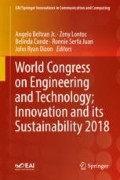Abstract
This study aimed to create a prototype that can detect level of calcium and pH to analyse whether the urine is positive of hypercalciuria – a condition of having high amount of calcium, uric acid crystallization (pH < 5.8), and calcium oxalate formation (pH > 6.8) in urine. Five subjects were tested for their pH level and calcium level with three trials each. Results from paired t-test showed that there are no significant differences in the mean values of the prototype-tested and laboratory-tested pH level (p = 0.310) and calcium level (n = 15. p = 0.781). This indicates that values obtained from two different methods such as using prototype sensor and laboratory testing imply closely related values provided by almost zero mean differences of the two parameters used.
This work was supported financially by the Philippines’ Department of Science and Technology–Engineering Research and Development for Technology (DOST–ERDT) through the scholarship program for graduate students.
Access this chapter
Tax calculation will be finalised at checkout
Purchases are for personal use only
References
Faridi, P., Seradj, H., Mohammadi-Samani, S., Vossoughi, M., Mohagheghzadeh, A., & Roozbeh, J. (2014). Randomized and double-blinded clinical trial of the safety and calcium kidney stone dissolving efficacy of Lapis judaicus. Journal of Ethnopharmacology, 156, 82–87.
Zarasvandi, A., Heidari, M., Sadeghi, M., & Mousapoor, E. (2013). Major and trace element composition of urinary stones, Khuzestan province, southwest, Iran. Journal of Geochemical Exploration, 131, 52–58.
Yaroshenko, I., Kirsanov, D., Kartsova, L., Sidorova, A., Borisova, I., & Legin, A. (2015). Determination of urine ionic composition with potentiometric multisensor system. Talanta, 131, 556–561.
Tiwari, A., Nipate, S., Bandawane, D., Bhandarkar, A., Londhe, V., & Soni, V. (2012). An overview on potent indigenous herbs for urinary tract infirmity : Urolithiasis. Asian Journal of Pharmaceutical and Clinical Research, 5(0974–2441), 7–12.
Jabbar, F., Asif, M., Dutani, H., Hussain, A., Malik, A., Kamal, M., & Rasool, M. (2015). Assessment of the role of general, biochemical and family history characteristics in kidney stone formation. Saudi Journal of Biological Sciences, 22(1), 65–68.
Curhan, G., & Taylor, E. (2008). 24-h uric acid excretion and the risk of kidney stones. Kidney International, 73(4), 489–496.
Taylor, E., Stampfer, M., & Curhan, G. (2005). Obesity, weight gain, and the risk of kidney stones. JAMA, 293(4), 455.
Jawalekar, S., Surve, V., & Bhutey, A. (2010). The composition and quantitative analysis of urinary calculi in patients with renal calculi. Nepal Medical College Journal, 12(3), 145–148.
Alok, S., Jain, S., Verma, A., Kumar, M., & Sabharwal, M. (2013). Pathophysiology of kidney, gallbladder and urinary stones treatment with herbal and allopathic medicine: A review. Asian Pacific Journal of Tropical Disease, 3(6), 496–504.
Laube, N., Pullmann, M., Hergarten, S., Schmidt, M., & Hesse, A. (2003). The alteration of urine composition due to stone material present in the urinary tract. European Urology, 44(5), 595–599.
Robertson, W. (2012). Methods for diagnosing the risk factors of stone formation. Arab Journal of Urology, 10(3), 250–257.
Worcester, E., & Coe, F. (2010). Calcium kidney stones. New England Journal of Medicine, 363(10), 954–963.
Acknowledgement
This study is funded by the Department of Science and Technology (DOST), under the scholarship program for master’s degree in Engineering Research and Development for Technology through the academic support of Mapúa University.
Author information
Authors and Affiliations
Corresponding author
Editor information
Editors and Affiliations
Rights and permissions
Copyright information
© 2020 Springer Nature Switzerland AG
About this paper
Cite this paper
Pula, R., Garcia, R. (2020). Determination of Calcium and pH Level in Urine for Calcium-Based Kidney Stone Diagnosis Using Arduino Microcontroller. In: Beltran Jr., A., Lontoc, Z., Conde, B., Serfa Juan, R., Dizon, J. (eds) World Congress on Engineering and Technology; Innovation and its Sustainability 2018. WCETIS 2018. EAI/Springer Innovations in Communication and Computing. Springer, Cham. https://doi.org/10.1007/978-3-030-20904-9_7
Download citation
DOI: https://doi.org/10.1007/978-3-030-20904-9_7
Published:
Publisher Name: Springer, Cham
Print ISBN: 978-3-030-20903-2
Online ISBN: 978-3-030-20904-9
eBook Packages: EngineeringEngineering (R0)

